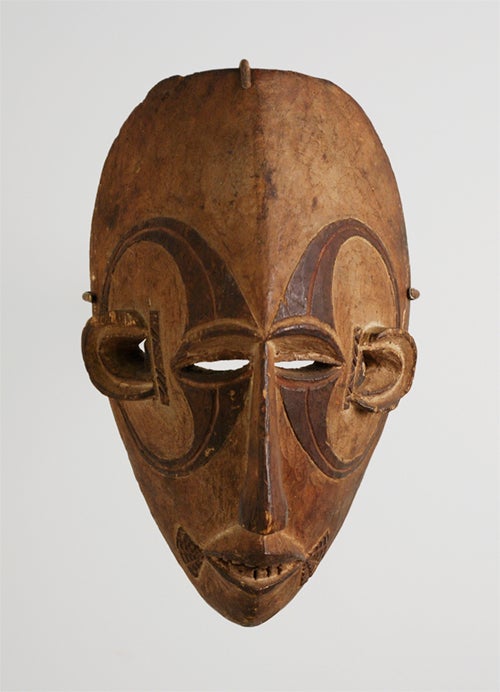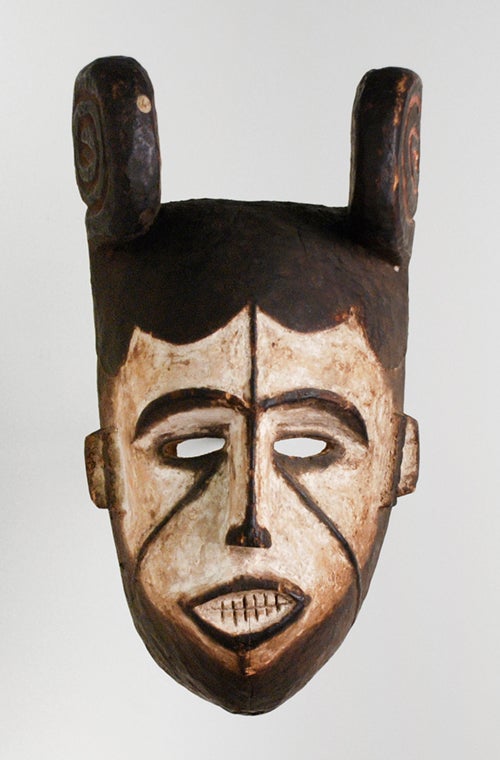The Art of Transformation: Igbo Masks by Ugbozo Ozooha-Aga from the Phoebe A. Hearst Museum of Anthropology
The Art of Transformation:
Igbo Masks by Ugbozo Ozooha-Aga from the Phoebe A. Hearst Museum of Anthropology
 Masks are one of West Africa's most enduring and compelling art forms. West Africa ranges from Nigeria to the Atlantic Ocean and as far north as Senegal and Mali. The use of masks in this area spans hundreds and perhaps thousands of years. Skilled craftsmen make masks, which are usually carved from wood and painted; they may also incorporate cloth, beads, shells, and raffia. West African masks cover the face or the head and are always worn with a costume.
Masks are one of West Africa's most enduring and compelling art forms. West Africa ranges from Nigeria to the Atlantic Ocean and as far north as Senegal and Mali. The use of masks in this area spans hundreds and perhaps thousands of years. Skilled craftsmen make masks, which are usually carved from wood and painted; they may also incorporate cloth, beads, shells, and raffia. West African masks cover the face or the head and are always worn with a costume.
The Igbo (pronounced Ee-boh) of southeast Nigeria are one of the many West African peoples that hold numerous masked performances each year to honor ancestors, insure bountiful crops, teach moral lessons, and entertain audiences at festivals. Maskers, often referred to as mmanwu, also perform special rituals at ceremonies and rites of passage. Prior to the early 1900s, mmanwu played important judicial and policing roles in Igbo society. Masquerades typically occur outside during the dry season when harvest celebrations take place.
Ancestors are revered and commemorated in Igbo culture, and mmanwu personify ancestral spirits during performances. Contrasting elements such as good and evil, male and female, and beauty and ugliness, are also reflected in both masks and masquerades. Masked performers transform themselves into virtuous maidens, esteemed ancestors, animals, jokers, powerful male figures, and other supernatural characters. The real identity of mmanwu is always hidden. Men play the role of masqueraders, and boys must complete initiation ceremonies in order to become part of secret masking societies.
 Maskers may appear individually or in large groups. Mmanwu disguise their voices, utter strange noises, sing, recite proverbs, use whistles, or remain silent. Unmasked attendants frequently accompany maskers, adding to their powerful presence. Dance and body movement bring masked characters to life. Music is an essential component of masquerades and involves drums, gongs, rattles, and flutes. Masquerades last for several hours to several days or may even occur over the course of many months. Masking traditions continue to evolve and reflect modern social conditions. The Igbo create new types of masks, occasionally incorporating contemporary materials such as plastic and aluminum, and some masquerades have been adapted for urban and stadium settings.
Maskers may appear individually or in large groups. Mmanwu disguise their voices, utter strange noises, sing, recite proverbs, use whistles, or remain silent. Unmasked attendants frequently accompany maskers, adding to their powerful presence. Dance and body movement bring masked characters to life. Music is an essential component of masquerades and involves drums, gongs, rattles, and flutes. Masquerades last for several hours to several days or may even occur over the course of many months. Masking traditions continue to evolve and reflect modern social conditions. The Igbo create new types of masks, occasionally incorporating contemporary materials such as plastic and aluminum, and some masquerades have been adapted for urban and stadium settings.
The Art of Transformation features masks made by Ugbozo Ozooha-Aga of Obiama, Nigeria that were collected by the anthropologist William R. Bascom in 1945. The Igbo masks on view "are part of a unique collection of more than one hundred masks produced by a single African wood-carver, and probably the only available 'one-man show' of traditional African art." The carvings in this exhibition embody an incredible range of styles. As Bascom himself described, "Large and small, simple and complex, roughly carved or carefully finished, abstract or realistic, these masks represent terrifying spirits, humorous figures,
and beautiful women."
[top inset image]
Maiden Mask c. 1930–45
Made by Ugbozo Ozooha-Aga; Igbo; Obiama, Nigeria, West Africa
wood, pigment
Collection of the Phoebe A. Hearst Museum of Anthropology
L2009.0201.061
[bottom inset image]
Mask c. 1930–45
Made by Ugbozo Ozooha-Aga; Igbo; Obiama, Nigeria, West Africa
wood, pigment
Collection of the Phoebe A. Hearst Museum of Anthropology
L2009.0201.022
Photography is not permitted.
©2009 by San Francisco Airport Commission. All rights reserved.